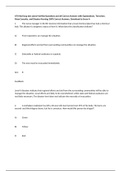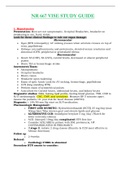Exam (elaborations)
BTEC Level 3 Applied Science Unit 2- Practical Scientific Procedures and Techniques Learning Aim A: Undertake colorimetry to determine the concentration of solutions
- Institution
- PEARSON (PEARSON)
BTEC Level 3 Applied Science Unit 2- Practical Scientific Procedures and Techniques Learning Aim A: Undertake colorimetry to determine the concentration of solutions Distinction level
[Show more]












